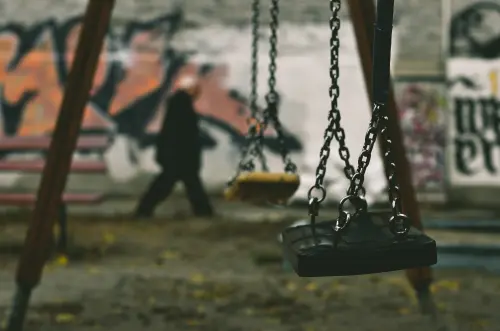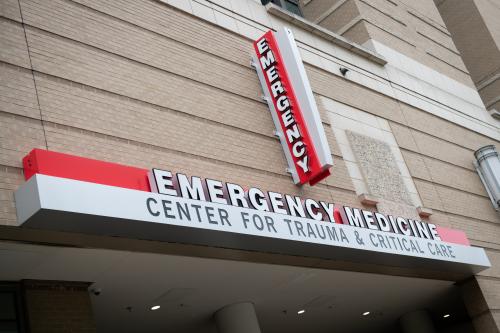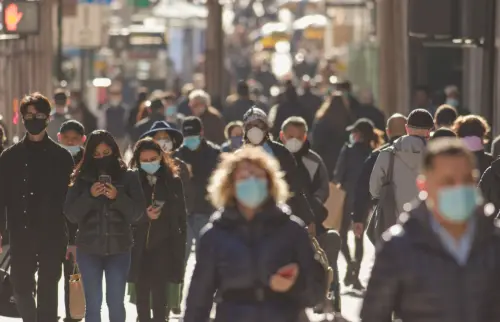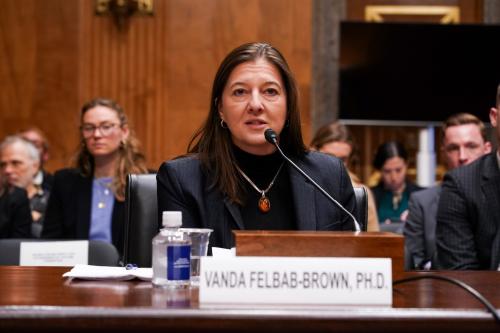Several recent incidents underscore the risks when we expect police to resolve incidents involving people experiencing crises associated with behavioral health or developmental disorders. Sometimes the results are tragic, such as the death of Daniel Prude in Rochester, New York, the shooting in Utah of a 13-year-old boy with autism, and the killing of Walter Wallace in Philadelphia. Such episodes raise questions about what role – if any – police should play in such cases.
A significant part of the problem is the long-standing, inadequate level of mental health services in the United States. A 2019-2020 report produced by The Blue Ridge Academic Health Group, which advises academic medical centers, draws attention to the sharp reduction in the number of inpatient psychiatric beds since the 1960s. It was intended that such “deinstitutionalization” would be accompanied by increased community-based care, but that has been insufficient. This inadequate access to care may explain an analysis of police calls in Washington D.C., showing calls from family and friends disproportionately involve mental illness. With racial minorities more often living in under-resourced communities and so less likely to be properly diagnosed with mental illness and receive adequate treatment, it becomes more probable that police may be called to deal with a minority individual experiencing a mental health crisis.
The Treatment Advocacy Center estimated in 2015 that people with untreated mental illness are 16 times more likely to be killed during a police encounter than other civilians approached or stopped by law enforcement. A study in the American Journal of Preventive Medicine, using data covering 2009-2012, found that “one in five (21.7%) legal intervention deaths were directly related to issues with the victim’s mental health or substance-induced disruptive behaviors.” Meanwhile, surveys by the National Alliance on Mental Illness have found that people in a mental health crisis are more likely to encounter police than to get medical attention, resulting in two million people jailed every year.
A few jurisdictions, such as San Francisco, are considering removing police from dealing with many situations involving psychiatric conditions or substance abuse, and instead using mental health or emergency medical technicians (EMTs). Many others now provide regular police with special training for dealing with encounters involving people experiencing a mental health crisis.
Both these approaches have limitations. For example, if a situation turns violent, an EMT may not be able to prevent an individual in crisis from injuring themselves or other people. And while police training helps, regular patrol officers rarely receive more than very basic training and still often resort to force rather than more appropriate approaches.
The role of crisis response teams
Some jurisdictions, however, are taking a very different route. They are addressing both the lack of community-focused mental health resources and the dangers inherent in police encounters by creating specialized Crisis Intervention Teams (CIT) or similar approaches for dealing with people experiencing mental health or substance abuse crises. These teams are comprised of specially trained police officers and mental health professionals. They collaborate to address and de-escalate high-stress mental health situations, while having the range of skills required to handle possibly dangerous developments. The teams can also help individuals obtain longer-term care.
The following examples indicate the approaches of a variety of innovative CIT models across the country.
Anne Arundel County Crisis Intervention Model— Maryland
Anne Arundel County’s Crisis Intervention Unit utilizes a combination of techniques. In 2002, the county expanded its system of Mobile Crisis Teams (MCT) to help manage individuals with needs, and in 2014, with resources from the county police department and the Maryland Behavioral Health Administration, the county added CITs to deal with cases deemed too dangerous for regular mental health professionals. The system now includes:
- Community Warmline and Safe Stations: An around-the-clock Community Warmline is part of the county’s Crisis Response System. The Warmline helps to divert non-emergency calls from the police department and have them instead handled by trained staff who can assist callers with “information, support, and referrals.” Fire and police stations also function as Safe Stations, where individuals can receive screenings and follow-up from an MCT.
- Mobile Crisis Teams and Crisis Intervention Teams: The Crisis Response System was originally designed to respond to police calls—when a police officer was on scene and recognized a situation that might require a mental health professional, they could call for a MCT. These teams include two clinicians: one an independently licensed mental health professional, and the other a masters level clinician. The team responds to a police radio call and is a valuable tool for patrol officers who have options other than making an arrest. The team system has evolved with Crisis Intervention Teams (CIT) comprised of one highly trained police officer paired with an independently licensed clinician. CITs respond directly to 911-dispatches involving more serious situations, including barricades, weapons in home, extreme risk protection orders and domestic violence.
- Police Training: In 2015, Anne Arundel county became the first police department in the country to have trained every officer in mental health first aid. Since then, according to county officials, the county’s use of force has dropped by 21 percent. Every officer in the department now receives 8 hours of mental health first aid, 4 hours of SAMHSA training, and other mental health-focused training sessions. But the CIT officers – who are volunteers – undertake a rigorous 40 hour specialized behavioral health course.
In collaboration with the healthcare system, Anne Arundel County’s Mobile Crisis Response Team also coordinates follow-up care through one-on-one care coordination when an individual is released from the Emergency Department or a jail after a mental health crisis. When they are discharged, the crisis team picks up the individual from the hospital or jail and the clinician works with a nurse or community health worker to ensure that there is a safety plan in place. Police officers and clinicians also work together to ensure that the individual and their family is also given an overview of the criminal justice system and collaborate on health resources when a person is arrested due to a mental health crisis. The goal of this diversion program is to address any barrier that an individual may have so that they can adhere to their treatment plan and be successful. With this program, Anne Arundel County has experienced significantly lower recidivism rate for these individuals.
CAHOOTS—Eugene, Oregon
The Crisis Assistance Helping Out on the Streets (CAHOOTS) program is an initiative led by the White Bird Clinic, a Federally Qualified Health Center (FQHC) located in Eugene, Oregon. The program consists of two-person teams: one medic, nurse, paramedic, or EMT; and a crisis worker trained in social and behavioral health services. CAHOOTS calls come in through Eugene’s 911 system through which local police dispatchers are trained to recognize non-violent, behavioral health focused situations and can route calls directly to the CAHOOTS team. The specialized team responds – without police officers – to first assess the situation. If necessary, the team can then call for immediate police backup; otherwise, the team stabilizes the individual within the community. When there is a case of urgent medical need or psychological crisis, the team can undertake an assessment, supply information and referrals, or provide transportation to the next step in treatment. In 2019, of the 24,000 CAHOOTS calls received, police backup was requested only 150 times. The budget for CAHOOTS is about $2.1 million annually.
LEAD Program— Seattle, Washington
Seattle’s Law Enforcement Assisted Diversion (LEAD) program is an example of a series of programs across the country in which law enforcement and court officials seek to avoid prison sentences for apprehended individuals with drug-related problems. The Seattle program began in 2011 as a pilot, funded by private foundations. Police officers who knew the community and individuals with frequent arrests were enrolled in the program. Individuals enrolled in LEAD receive immediate access to substance use treatment and social services such as rental assistance, job training, and mental health programs. In exchange for their participation, no criminal charges are filed, even if they later relapse. With calls for police reform in Seattle, the LEAD program is currently being restructured as the Let Everyone Advance with Dignity program, and a new option for LEAD operations is being re-developed to remove law enforcement from the center of the program and to have a more healthcare-driven perspective.
Albuquerque Community Safety— Albuquerque, New Mexico
Since February 2018, the Albuquerque Police’s Mobile Crisis Team approach consists of unarmed police officers and mental health professionals responding to mental health crises. Within Bernalillo County, six Mobile Crisis Teams (MCTs) now provide this specialized response to 911-calls related to behavioral health. The two-person teams consist of one MCT-trained law enforcement officer and an MCT-trained master’s level behavioral health clinician. In June 2020, New Mexico’s Institute for Social Justice reported that almost half of the more than five thousand calls received since the program’s inception have been suicide or behavioral health incidents.
In the summer of 2020, in response to public pressures to reform the police, the mayor of Albuquerque announced an initiative to restructure the MCTs into a new cabinet-level department of first responders for mental health crises. Named Albuquerque Community Safety (ACS), it will serve alongside the Albuquerque Police Department and Albuquerque Fire Rescue to deliver what Albuquerque mayor Tim Keller described as a “civilian-staffed, public health approach” to public safety and mental health. ACS will be staffed by trained professionals such as social workers, housing and homelessness specialists, and violence prevention and diversion program experts. ACS will allow trained 911 dispatchers the option to send ACS personnel when a community safety response is more appropriate than an armed police officer, paramedic, or firefighter. The initiative is planned to begin by the end of 2020.
What is next?
These examples are consistent with a pattern of actions across the country. Some jurisdictions are creating or expanding police/health professional teams. Others are seeking to remove police entirely from addressing mental health and some drug incidents. In Rochester, for example, following the death of Daniel Prude, the mayor has moved their family crisis intervention team and its funding out of the police department and into the department of youth and recreation services.
With the increasing attention given to the role and conduct of police officers in situations involving individuals undergoing a mental health crisis, it is likely that more jurisdictions will consider changes in the role of the police and such innovations as crisis intervention teams. But in doing so, they will need to ponder several issues, including:
- Expanded access to behavioral health treatment. Resorting to the police during a person’s mental health crisis underscores the gaps and weaknesses in mental health services in America. Many individuals end up encountering armed police because adequate and sustained care is not available to them, either in outpatient services or – when needed – institutional care.In recent years Congress has taken some modest steps to improve the level and quality of services, such as the 21st Century Cures Act of 2016, which included new federal grants and coverage requirements on health plans. Furthermore, in October, the House-passed the HEROES Act, which includes federal grant funding to states, local governments, community-based organizations, and providers to help address behavioral health needs related to COVID; money would be available for mobile crisis units, crisis call centers, and medically staffed crisis stabilization programs (as of writing, there has been no Senate agreement on the legislation). But until more comprehensive steps are taken, many Americans will still receive inadequate care.
- Training issues. Questions remain regarding the adequacy and effectiveness of training regular police force to deal with mental health crises, compared with specialized training for selected officers to work in CIT teams with mental health professionals. To be effective, general training needs to help officers understand the complexities of mental health in their communities.Still, such training modules tend to be short and must compete for attention with other areas of training. The experience of many jurisdictions, including the recent tragic cases, indicates that general training for police officers cannot be counted on to avoid disastrous incidents. Establishing CIT programs, like that in Anne Arundel county, requires a larger investment in training for select, volunteer officers.
- Measuring results. In addition to lives saved, investments in crisis intervention strategies suggest that there will be “downstream” public savings in other areas, including in police time, court, and incarceration costs. More research is needed to indicate the degree that community-level interventions produce health system savings, such as avoiding costs associated with individuals through a cycle of emergency room visits or incarceration.To date, however, there have been few analyses of CITs to demonstrate the potential return on investment. This needs to be remedied. To be able to make the case for reallocating funds, governments and private sector researchers will need to both develop better data collection and undertake rigorous evaluations of the growing number of CIT programs. These evaluations will need to include the total costs and potential savings in health care, policing, incarceration, and other sectors.
- Creating networks of CIT pilots. Many jurisdictions piloting CIT strategies operate in isolation, largely unaware of what other jurisdictions are doing. For these collaborative approaches to spread, therefore, and for jurisdictions to learn from each other, there needs to be improved networking and sharing of best practices.Fortunately, there are institutions taking the lead in this effort. The National League of Cities, for example, has been sharing information and best practices with city leaders across the nation. The federal Bureau of Justice Assistance similarly shares good practice with police forces. Abt Associates and Arnold Ventures have created a guidebook for jurisdictions considering crisis response programs. Other organizations sharing information and developing networks include CIT International, the National Alliance on Mental Illness, and CIT Inc.
- Budget challenges. Even if jurisdictions are convinced that there are budget savings, investment in crisis intervention teams will tend to be far less than optimal because of a classic “wrong pockets” problem. Such a problem arises when the program or department making the investment is not the one that accrues the savings. Thus, as is the case of CITs, a police department or a department of health may incur the costs of training and personnel, but savings occur to other departments or even other levels of government, such as to the prison system or to Medicaid. That wrong pocket distribution of costs and benefits makes it harder for budget managers in, say, a police department, to justify spending on non-police mental health staff amid the normal interdepartmental competition for funds.There are some partial remedies to this problem. One step is to develop meticulous projections of cross-department costs and benefits to help persuade budget planners at the jurisdictional level. Another is to organize CIT activities within offices or new departments that are funded directly rather than having to compete for internal funds – Albuquerque’s decision to create a new cabinet department is an example. A third way is to explore the use of novel types of funding, such as privately funded pay for success models.
- Routing emergency calls. A crisis system can be well-organized and well-funded, but if a dispatcher responds to a mental health crisis call by sending armed police rather than a crisis team or an ambulance, the results can be tragic. Thus, dispatcher training is crucial to success, as is a clear protocol for handling possible mental health calls, including better planning between the police department and other services. In San Francisco, for instance, all mental health-related calls are coded 800, a city specific police-transmission code for a “report of a mentally disturbed person” and transferred to the crisis team.Some jurisdictions add another layer of coordination by creating an alternative number for calls related to mental health crises that are routed to specialist professionals rather than to regular police dispatchers. In Labrador, Canada, for instance, friends or family can call 811 for mental health emergencies. And just this summer, the U.S. Federal Communications Commission voted to establish a new 988 number for mental health crisis calls.
- Federal encouragement. The federal government could expand on the assistance provided by such agencies as the Bureau of Justice Assistance through as more coordinated leadership role. An interagency body, perhaps modeled on the U.S. Interagency Council on Homelessness, could help different federal departments – such as the Department of Justice and Health and Human Services – work together and with state and local jurisdictions. The federal government could also help in the building of information networks and help sponsor the research necessary to make the budget case for teams and to improve techniques.
The recent episodes of police injuring or killing individuals with mental illness in crisis have highlighted the argument that police officers are often not the right first responders in many such situations—especially given the procedures that officers typically are expected to follow when there is an apparent risk to public safety. Fortunately, there are now a growing number of jurisdictions that have adopted a team approach to these incidents, in which mental health professionals can de-escalate the situation, with trained police protection in support. These promising programs need to be studied for their effectiveness and design; they suggest that the role of the police needs to be modified significantly when mental illness may be involved in an emergency call.







